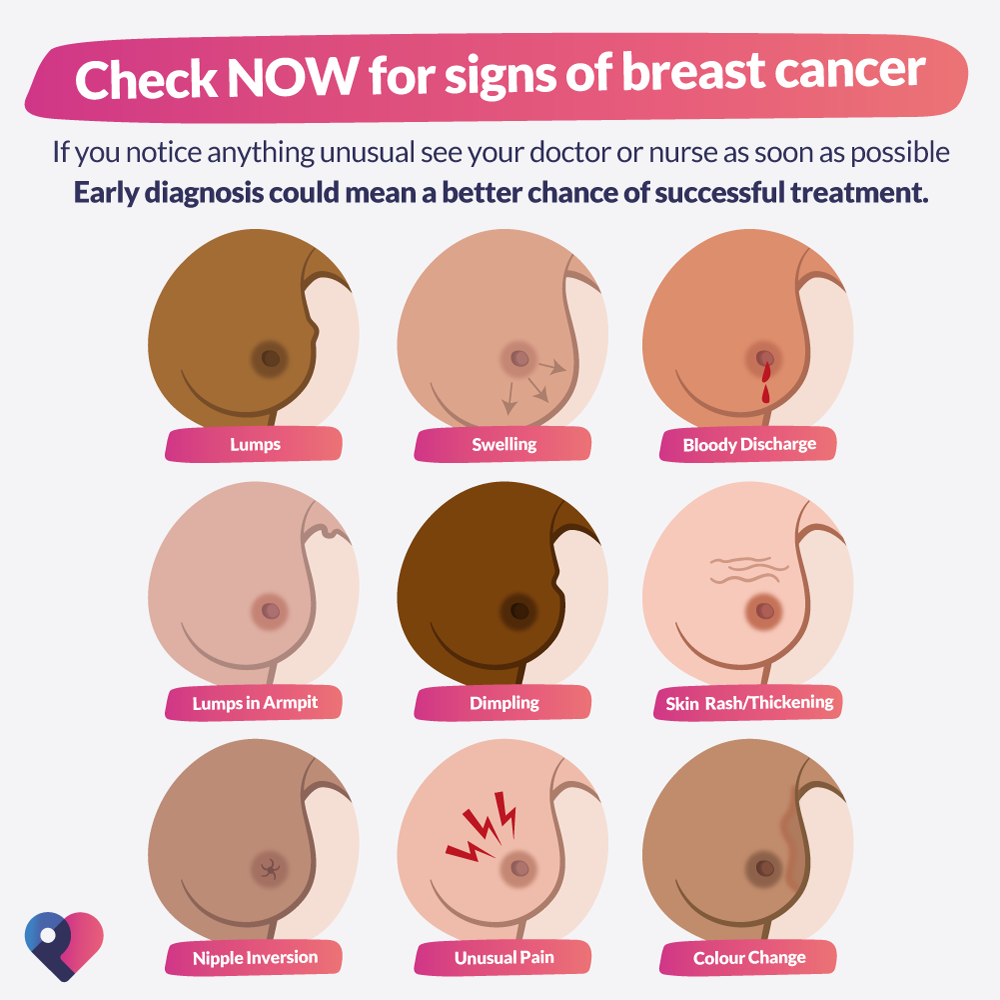
Cómo detectar el cáncer de mama y cómo se siente un bulto
Peer reviewed by Dr Colin Tidy, MRCGPLast updated by Lynn StephenLast updated 1 Oct 2025
Satisface las necesidades del paciente directrices editoriales
- DescargarDescargar
- Compartir
- Idioma
- Debate
Según Cancer Research UK, cada año se producen unos 56.000 nuevos casos de cáncer de mama -más de 150 cada día-, lo que convierte al cáncer de mama en el más frecuente en el Reino Unido. Es importante que sepas cómo revisarte los pechos y cuándo hacerte una revisión. Aunque creas que no es nada, esa cita podría salvarte la vida.
En este artículo:
El cáncer de mama es el crecimiento anormal de las células mamarias, que da lugar al desarrollo de tejido mamario canceroso, conocido como tumor. Estos tumores pueden aparecer y sentirse como pequeños bultos en el pecho, y también hay otros síntomas a los que prestar atención.
Seguir leyendo
¿Cómo se siente un bulto de cáncer de mama?
According to GP Dr Sarah Cooke, a breast lump can feel different for each person. She explains that they are sometimes pea-like in size and texture, other times they may be bigger and feel hard and irregular.
"They can occur anywhere in the breast or in the armpit," she says. "It is important to check your breasts as well as armpits when self-examining."
¿Cómo se comprueba si hay un bulto?
Cómo revisar tus pechos

Cooke’s guide to checking your breasts
1. Conozca sus pechos
It's harder to look for changes if you're not familiar with your breasts. For example, it's common to have one bigger than the other. Familiarise yourself with their differences and similarities.
2. Mirar con un espejo
Look for changes in shape and size - this includes any swelling, dimpling - when skin appears to be pulled inward or puckered, and looking to see if the shape/size difference between both breasts seems greater than usual.
Busca otros cambios en la piel, como sequedad inexplicable, enrojecimiento y erupciones.
Busca cambios en los pezones, como secreciones, erupciones cutáneas y pezones vueltos hacia dentro.
Busque cambios debajo de los brazos/ axilas - levante los brazos por encima de la cabeza y busque las mismas señales de advertencia anteriores.
3. Toca con las manos
Tumbado, coloque la mano derecha sobre el pecho izquierdo y ejerza una ligera presión.
Mueve la palma de la mano alrededor del pecho con un movimiento circular: empieza por la clavícula y crea una espiral alrededor de todo el pecho hasta llegar al pezón en el centro. No te olvides de la parte inferior del pecho.
Fíjese en cualquier bulto o hinchazón que le resulte extraño.
Repita en el otro lado.
Siga los pasos 1-4 anteriores en las axilas.
Sentada, examine ambos senos y axilas de la misma manera. Hacemos esto porque es posible que sienta mejor zonas diferentes en ambas posiciones.
Seguir leyendo
¿Se nota siempre un bulto en el pecho?
A lump might feel different, depending on several factors, such as breast size and age. For example, in larger breasts it's easier to miss lumps. To the eye, the breast may look different, the contours may change, or you may notice an obvious lump or swelling. You might notice visible changes, such as fluid leaking from the nipple, rashes, or redness, but could also experience breast pain, which might not have an obvious cause.
Algunas personas no se dan cuenta de que tienen un bulto, pero su cáncer puede detectarse mediante una prueba de cribado(mamografía) más adelante, durante el cribado mamario normal en el Reino Unido. También existen pruebas genéticas para detectar el cáncer de mama.
However, your doctor can talk you through how to self-examine your breasts - plus, there are online tutorials and graphics - such as the one above - to guide you through.
¿Con qué frecuencia debe revisarse los senos?
You should check your breasts regularly, even if you have not felt a lump in the past. Checking your breasts every two weeks - or up to once a month - helps you identify what feels normal to you and makes it easier to notice when something is out of the ordinary.
It's advised to check them on the same day each month - around a week after your period. The process shouldn't take long but be sure that you are thorough.
Puedes autoexplorarte delante de un espejo, pero un buen consejo es hacerlo en la ducha o el baño, ya que los bultos y protuberancias pueden ser más fáciles de identificar cuando la piel está húmeda.
Lo que busca es una diferencia con respecto al examen del mes pasado. Por lo tanto, debe conocer la disposición y la sensación normal de sus propios pechos. Si le sirve de ayuda, puede dibujar un diagrama para saber dónde se encuentra cualquier bulto o surco.
Seguir leyendo
Cuándo hacerse revisar un bulto
Cooke outlines the things that might be abnormal that you should get checked out by a doctor, just to be on the safe side. It might be nothing, but it's always better to get it looked at to save yourself the worry. Plus, early intervention and treatment can be key to cancer survival.
Seek a review by a doctor if you have:
Un nuevo bulto en el pecho.
Un nuevo bulto en la axila.
Cambios en el pezón: cambio en la ubicación del pezón, inversión del pezón, secreción del pezón o cambios en la piel alrededor del pezón, como eccema.
Cambios en la piel de los pechos: erupciones o eczemas.
Cambios en el color de la piel.
Arrugas u hoyuelos en la piel: la piel aparece tirante.
Cooke says that when you see a doctor regarding a breast lump or changes of concern, they will ask about your medical history and whether there is a family history of breast cancer. They will look at your medicines and whether you smoke or drink alcohol - which is often on your medical record.
"They'll also ask how you noticed the lump and will likely offer an examination and a referral if there is anything of concern," she says.
¿Cómo se desarrolla el cáncer de mama?
The most common place for cell changes is in the lining of the milk ducts of the breast. A smaller number of breast cancers affect the breast lobules - the gland that makes milk.
Ductal carcinoma in situ (DCIS) is considered the earliest form of breast cancer. This is when abnormal cells are in the milk ducts. It is non-invasive, meaning it hasn't spread out of the milk duct to surrounding tissue. It also has a low chance of becoming invasive.
According to Cooke, there are many reasons why breast cancer develops and lots of these are things you can control yourself - modifiable risk factors.
Cooke advises that taking the combined contraceptive pill increases your chance of breast cancer very slightly - but it also reduces your risk of ovarian and womb cancer, so the benefits often outweigh the risks.
She says: "Using hormone replacement therapy (HRT), particularly if it is a combined HRT preparation and used for longer than five years, can also increase the likelihood of breast cancer. HRT taken for five years or fewer does not significantly increase breast cancer risk."
Other risk factors of breast cancer that are not under your control include:
Antecedentes familiares de cáncer de mama.
Mutaciones genéticas familiares (BRCA1 y BRCA2).
Aumento de la edad.
Empezar a menstruar antes de los 12 años y tener la menopausia más tarde.
Antecedentes de cáncer de mama previo.
Cooke explains that those who have not given birth to children have a slightly increased chance of breast cancer.
Women who are older than 30 when they give birth to their first child have a higher chance of breast cancer than women who have never given birth. But, those who have never given birth can also have an increased chance of developing breast cancer compared with those who have children during their twenties.
Cooke explains that you can potentially reduce your chance of breast cancer by living an active lifestyle, maintaining a body mass index (BMI) between 18.5 to 25, and breastfeeding if you have children. The longer you breastfeed your baby, the lower your risk of breast cancer becomes. It is not fully known why this is, but it's thought that the ovaries don't produce eggs as often while someone is breastfeeding, and the development of breast cancer is related to exposure to hormones produced by the ovaries.
¿Pueden los hombres padecer cáncer de mama?
Aunque el cáncer de mama suele afectar sobre todo a las mujeres, los hombres también pueden padecerlo. En raras ocasiones, el cáncer puede desarrollarse en la pequeña cantidad de tejido mamario que hay detrás de los pezones masculinos.
El cáncer de mama en los hombres suele afectar sólo a los que tienen entre 60 y 70 años, pero también existe la posibilidad de que se desarrolle en hombres más jóvenes.
El principal síntoma del cáncer de mama en el tejido mamario masculino es un bulto, pero el pezón también puede verse afectado, como un cambio de forma, color, posición o secreción.
También se debe animar a los hombres a que comprueben si hay bultos y acudan al médico si sienten algo fuera de lo normal.
Patient picks for Breast cancer

Cáncer
Atención precoz del cáncer de mama
El cáncer de mama es el tipo de cáncer más frecuente en el Reino Unido. Afectará a 1 de cada 7 mujeres británicas a lo largo de su vida y, como cada vez vivimos más años, es cada vez más frecuente. Pero también hay buenas noticias. Gracias a los avances en los tratamientos y a las pruebas de detección precoz del cáncer de mama, las tasas de supervivencia han mejorado; de hecho, casi se han duplicado en los últimos 40 años. Pero para optimizar sus posibilidades de vencer la enfermedad, el tratamiento precoz es crucial, y eso significa saber qué buscar y no retrasar las revisiones.
por la Dra. Sarah Jarvis MBE, FRCGP

Salud de la mujer
Cáncer de mama
El cáncer de mama es el más frecuente entre las mujeres. La mayoría de los casos se dan en mujeres mayores de 50 años, pero el cáncer de mama puede aparecer en mujeres más jóvenes. Si el cáncer de mama se diagnostica en una fase temprana, es posible que se necesite menos tratamiento y que éste sea más eficaz. En general, cuanto más avanzado está el cáncer (cuanto más ha crecido y se ha extendido), menos posibilidades hay de que el tratamiento sea curativo. Sin embargo, los tratamientos mejoran constantemente y a menudo pueden ralentizar el avance del cáncer. Más de 3 de cada 4 mujeres diagnosticadas de cáncer de mama siguen vivas 10 años después.
por la Dra. Hayley Willacy, FRCGP
Seguir leyendo
Historia del artículo
La información de esta página ha sido revisada por médicos cualificados.
Next review due: 30 Sept 2028
1 Oct 2025 | Latest version
30 Sept 2022 | Publicado originalmente
Autores:
Emily Jane Bashforth

Pregunte, comparta, conecte.
Explore debates, formule preguntas y comparta experiencias sobre cientos de temas de salud.

¿Se encuentra mal?
Evalúe sus síntomas en línea de forma gratuita
Sign up to the Patient newsletter
Your weekly dose of clear, trustworthy health advice - written to help you feel informed, confident and in control.
By subscribing you accept our Privacy Policy. You can unsubscribe at any time. We never sell your data.